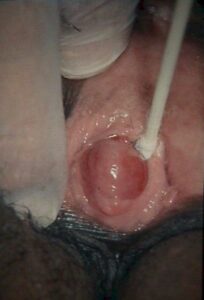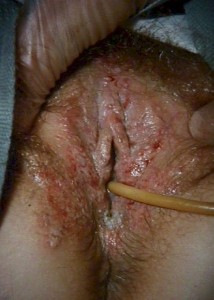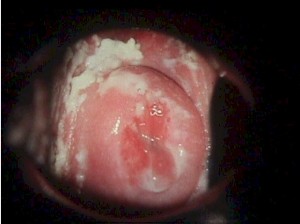Painful Urination
Painful urination is among the classical symptoms of bladder infection, along with frequency, urgency and sometimes hematuria. Such an infection can be confirmed by a positive urine culture (>100,000 colonies/ml), or strongly supported by a positive “dipstick” (for bacteria or leukocyte esterase) and a clinically tender bladder (normally the bladder is not the least bit tender).
Bladder infections are treated with broad-spectrum oral antibiotics (Sulfisoxazole, trimethoprim-sulfamethoxazole, ampicillin, cephalexin, Nitrofurantoin, etc.). Immediate relief of symptoms will occur with phenazopyridine 200 mg PO TID for 2 days.
Should symptoms persists despite a course of broad spectrum antibiotics, a careful examination should be made and further testing is appropriate.
Gonorrheal Urethritis

Urinary frequency and burning in a patient with a history of exposure to gonorrhea suggests gonorrheal urethritis.
The urethra is normally not tender. Should the urethra be tender, particularly if combined with a purulent discharge, urethritis should be suspected.
Paraurethral abscesses (infected Skene’s glands), and eversion of urethral epithelium are often found.
This diagnosis is confirmed by gram-negative intracellular diplococci on Gram Stain or positive culture on Thayer-Martin media (chocolate agar).
Should the operational environment disallow this precise workup, treatment is often provided on the basis of clinical suspicion and symptoms, or after a failed course of broad-spectrum antibiotics provided for a suspected UTI.
Recommended Regimens (CDC 2021)
Ceftriaxone 500 mg* IM in a single dose for persons weighing <150 kg
If chlamydial infection has not been excluded, treat for chlamydia with doxycycline 100 mg orally 2 times/day for 7 days.
* For persons weighing ≥150 kg, 1 g ceftriaxone should be administered.
Alternative Regimens (CDC 2021)
If cephalosporin allergy:
Gentamicin 240 mg IM in a single dose
PLUS
Azithromycin 2 g orally in a single dose
If ceftriaxone administration is not available or not feasible:
Cefixime 800 mg* orally in a single dose
* If chlamydial infection has not been excluded, providers should treat for chlamydia with doxycycline 100 mg orally 2 times/day for 7 days.
Sexual partners also need to be treated. Skene’s abscesses should have I&D followed by daily packing with iodoform gauze for 2-4 days.
Non-gonorrheal Urethritis
These patients complain of symptoms suggesting cystitis (frequency, burning, and urgency), but the urine culture is negative and they do not improve on conventional antibiotic therapy.
A purulent discharge from the urethra may or may not be present, but the urethra is tender to touch.
Cultures from the urethra may be positive for chlamydia, Mycoplasma or Ureaplasma, but will be negative for gonorrhea.
Treatment may be started on the basis of clinical suspicion alone.
Recommended Regimens (CDC 2021)
Doxycycline 100 mg orally 2 times/day for 7 days
Alternative Regimens (CDC 2021)
Azithromycin 1 g, orally in a single dose
OR
Azithromycin 500 mg orally in a single dose; then 250 mg orally daily for 4 days
Herpes Vulvitis

Painful urination in which the vulva burns when the urine drips across it can the primary symptom of herpes. In this case, inspecting the vulva will reveal multiple, small (1-2 mm), tender ulcers filled with grayish material and perhaps some blisters that have not yet ruptured. Sometimes, the pain is so intense that urination becomes complete misery. A Foley catheter until the symptoms resolve is merciful.
Recommended Regimens for an Initial Infection (CDC 2021)
Acyclovir† 400 mg orally 3 times/day for 7–10 days
OR
Famciclovir 250 mg orally 3 times/day for 7–10 days
OR
Valacyclovir 1 gm orally 2 times/day for 7–10 days
* Treatment can be extended if healing is incomplete after 10 days of therapy.
†Acyclovir 200 mg orally five times/day is also effective but is not recommended because of the frequency of dosing.
Recommended Regimens for Recurrence (CDC 2021)
Acyclovir 800 mg orally 2 times/day for 5 days
OR
Acyclovir 800 mg orally 3 times/day for 2 days
OR
Famciclovir 1 gm orally 2 times/day for 1 day
OR
Famciclovir 500 mg once, followed by 250 mg 2 times/day for 2 days
OR
Famciclovir 125 mg 2 times/day for 5 days
OR
Valacyclovir 500 mg orally 2 times/day for 3 days
OR
Valacyclovir 1 gm orally once daily for 5 days
*Acyclovir 400 mg orally 3 times/day is also effective, but are not recommended because of frequency of dosing.
Recommended Regimens for Supressive Therapy (CDC 2021)
Acyclovir400 mg orally twice a day,
OR
Famciclovir250 mg orally twice a day,
OR
Valacyclovir500 mg orally once a day,
OR
Valacyclovir1.0 gram orally once a day.
Read more about Herpes Vulvitis
Yeast, Trichomonas

Pain on the vulva when urine passes over it can also be a symptom of yeast and less-commonly trichomonads. These infections should be apparent on inspection of the vulva/vagina and may be confirmed by microscopic examination of vaginal discharge.
Painful urination may also be a symptom of other gynecologic disease, not specifically related to the bladder. Endometriosis, for example, may initially present as painful urination with a tender bladder which does not respond to typical antibiotic therapy and all urine cultures will be negative.
Urinary Frequency
The overwhelming number of patients complaining of urinary frequency will have one of the following problems:
- Bladder infection (accompanied by dysuria).
- Excessive fluid intake (particularly just before bedtime).
- Increased stress.
- Some pelvic mass which is pressing on the bladder
Evaluation of urinary frequency involves asking the patient about her fluid intake habits and recent exposure to stress. A physical exam determines the presence or absence of:
- Bladder tenderness (suggesting cystitis or endometriosis)
- Pelvic mass (suggesting ovarian cyst, pregnancy, or fibroids)
In situations where the diagnosis is unclear, a urine culture or urine “dipstick” for bacteria, nitrates or leukocyte esterase may be helpful in identifying infection. A pregnancy test is sometimes enlightening.
Whenever infection is suggested, a course of oral broad-spectrum antibiotics is advised. If no infection is apparent and the patient acknowledges large fluid intake, reducing the intake some may be helpful. (don’t over-react to this…too little fluid intake can be a problem also.)If the patient has had a trial of antibiotics, and/or has a negative culture, it is certainly worth trying low dose anticholinergics (like 2.5 mg oxybutynin 2-3 times per day) for the stress component. In young women, it is often NOT a pelvic mass or infection: it is often just stress.
Blood in the Urine
A wealth of reasons can explain grossly visible blood in the urine.
In women of child-bearing age, not postpartum and not menstruating, the most frequent is cystitis or a bladder infection. Such an infection is usually accompanied by urinary frequency and painful urination. The bladder is tender to palpation and urine culture will be positive (>100,000 colonies/ml). Urine “dipstick” will be positive for bacteria, nitrates and leukocyte esterase in the typical case.
Treatment involves an oral broad-spectrum antibiotic (Sulfisoxazole, trimethoprim-sulfamethoxazole, ampicillin, cephalexin, Nitrofurantoin, etc.)
If all symptoms resolve and the hematuria does not return, no further evaluation is necessary. If the hematuria does not disappear or if the patient has repeated episodes of hematuria, then urologic consultation will be necessary to look for other causes of hematuria (renal stones, renal cell cancer, bladder cancer, endometriosis, etc.)
Bad Urinary Odor
This is usually a symptom of either a urinary tract infection (cystitis) or a vaginal infection.
Examining the patient to determine the presence or absence of Gardnerella, trichomonads, yeast, or a lost tampon may be helpful in excluding vaginal problems. A urine culture or urine “dipstick” for bacteria, nitrates or leukocyte esterase may be helpful in eliminating a bladder infection as the cause of the problem.
Certain foods are associated with an unusual odor in the urine (asparagus), as are certain antibiotics (ampicillin).
Cannot Urinate
If the patient cannot urinate at all, she will be in extreme distress with a distended, tender bladder.
Insert a Foley catheter and allow the urine to begin draining. After the first 500 cc of urine has drained, clamp the Foley to temporarily stop draining for 5-10 minutes before allowing another 500 cc to drain. Continue to drain the urine in 500 cc increments until empty. Severe bladder cramps may occur if the entire bladder is drained at one time of a large amount (>1000 cc) of urine. (Severe bladder cramps may occur anyway.) After the bladder is drained, leave the Foley catheter in place for a day or two to allow the bladder’s muscular wall to regain its’ normal tone. If there is more than about 700 cc in someone, you should leave the Foley 5 days. If truly overstretched, the bladder won’t recover its tone in 48 hours.
Try to determine why the patient couldn’t void. She may have recent trauma to the perineum or vagina, which caused swelling in the area of the bladder or urethra, obstructing flow. She may have a pelvic mass (ovarian cyst, uterine fibroids, pregnancy, etc.) which has distorted the anatomy and functionally blocked the urethra. She may have herpes and cannot urinate because of the severe pain, which is caused by urine flowing over open ulcers.
Outside of postpartum or post-surgical circumstances, being unable to urinate is very rare in women, and not a good sign. Urinary retention is a common presentation of MS. If it does not respond to 5 days of Foley placement, urologic consultation/evaluation is needed.
Bladder Training
After a day or two, remove the Foley catheter. Usually the patient will be able to urinate normally again. If there is any doubt, catheterize her for “residual volumes.”(RV) After she urinates, insert a catheter to completely empty the bladder. If the RV is less than 50 cc, no further catheterization is necessary. If the RV is greater than 50 cc, continue to catheterize her after each urination until the RV is less than 50 cc. If the RV is quite large (>300 cc), then the bladder has probably not regained its normal tone and you should simply leave the Foley catheter in place for a few more days.
Involuntary Loss of Urine
There are four primary forms of urinary incontinence:
- Loss of urine when coughing, sneezing or straining (“stress urinary incontinence”).
- Sudden, involuntary loss of urine accompanied by urgency (unstable bladder, irritable bladder, detrusor dyssynergia).
- Involuntary loss of urine upon rising or standing.
- Involuntary loss of urine at unpredictable times, not associated with urgency, frequency or other activities.
Stress Incontinence
Loss of urine when straining (stress urinary incontinence) affects nearly all women at some time in their life
If a woman’s bladder is full enough and she strains hard enough, some urine will escape, due to the shortness of her urethra, the fragility of the normal continence mechanism, and its vulnerability to trauma during intercourse and childbirth.
Genuine stress incontinence which occurs more or less daily and requires the patient to wear a pad to avoid soiling her clothing will require gynecologic or urologic consultation and usually surgery to repair the anatomic defect.
Lesser degrees of stress incontinence can be treated by:
- Kegel exercises (periodic tightening of the muscles of the pelvic floor 10-15 times a day for 4 weeks).
- Frequent emptying of the bladder and “double voiding” (re-emptying the bladder 10-15 minutes after the initial void) to keep the bladder as empty as possible.
- Elimination of caffeine, alcohol and tobacco (common bladder irritants) which may aggravate the incontinence.
- A course of oral antibiotics to eliminate the chance that a sub-clinical cystitis is aggravating the incontinence.
Irritable Bladder
Women with an “irritable bladder” will complain that when they suddenly get the urge to urinate, they must find a bathroom within 1-2 minutes or else they will actually lose urine involuntarily.
Evaluation of the irritable bladder will require gynecologic consultation, but a number of simple things can be done to relieve the symptoms while awaiting consultation. Eliminating caffeine, alcohol, and tobacco from the diet will reduce the stimulation of the bladder wall. “Double voiding” (emptying the bladder, waiting 10-15 minutes and then emptying the bladder again) will help fully empty the bladder and will reduce the stimulus. A course of oral antibiotic may eliminate any subclinical infection. Smooth muscle relaxants may also be helpful.
Urethral Diverticulum
Involuntary loss of urine upon standing or arising suggests the presence of a urethral diverticulum. This outpouching of the urethra collects and holds urine, releasing it at unpredictable times. Specialized instruments are needed to visualize most urethral diverticula and patients with this type of complaint should be evaluated through a gynecology or urology consultation. Nothing short of surgery is likely to help this particular problem.
Unpredictable Urine Loss
Unpredictable loss of urine not associated with urgency or activity suggests a neurologic cause. Such conditions as multiple sclerosus, spinal cord tumors, spinal disk compression and other neurologic problems should be considered. If a patient has a single episode of this type of urine loss, she can simply be reassured, but if she notes an on-going or worsening problem with this type of urine loss, careful neurologic evaluation should be performed.
Urinary Urgency
There are three primary reasons for urinary urgency:
- Cystitis (bladder infection)
- Irritable bladder (unstable bladder, detrusor dyssynergia)
- Stress
In women of child-bearing age, cystitis is the most frequent cause of this distressing symptom in which a patient suddenly has a powerful urge to urinate. Bladder infection is usually accompanied by urinary frequency and painful urination. The bladder is tender to palpation and urine culture is positive (>100,000 colonies/ml). Urine “dipstick” will be positive for bacteria, nitrates and leukocyte esterase in the typical case.
Treatment involves an oral broad-spectrum antibiotic (Sulfisoxazole, trimethoprim-sulfamethoxazole, ampicillin, cephalexin, Nitrofurantoin, etc.). If all symptoms resolve, no further evaluation is necessary. Persistent symptoms will usually necessitate a gynecologic or urologic consultation.
Women with an “irritable bladder” will complain that when they suddenly get the urge to urinate, they must find a bathroom within 1-2 minutes or else they will actually lose urine involuntarily. Evaluation of the irritable bladder will require gynecologic consultation, as described above.
Stress
Stress is commonly encountered. While the stressor cannot always be reduced, the body’s reaction to the stressor can, sometimes, be modified. Women who suffer from stress-induced urgency may benefit from counseling and stress-reduction techniques.
Pyelonephritis
A kidney infection.
These infections are characterized by CVA pain or tenderness, chills, fever, lassitude, and sometimes nausea and vomiting. They may be preceded by cystitis or may come without warning.
Treatment is vigorous antibiotic therapy (frequently IV antibiotics because of the seriousness of the illness) and brisk fluid intake (IV or PO).
Kidney Stones
Kidney stones are common. While occurring more frequently among men than women, they still represent a significant cause of abdominal pain. A distal ureteral stone, especially in the intramural tunnel of the bladder often causes severe frequency/urgency patterns of urination. The dehydration, which often accompanies deployment, predisposes military members to formation of stones.
Severe, acute, colicky, unilateral flank pain usually marks the passing of a kidney stone. The pain is:
- Unrelieved by position,
- Generally accompanied by gross or microscopic hematuria, and
- May produce nausea and vomiting.
While passing stones is very unpleasant for the patient, it is not life threatening. Only in the event of upper tract infection or a solitary kidney is the obstruction associated with a passing stone a true medical emergency. In the absence of these two factors, the goal of treatment is pain relief and hydration.
Appropriate work-up of kidney stones depends on the patient presentation and available facilities. In the absence of fever or other evidence of UTI, treat the patient empirically with IV hydration and IV pain medications (Ketorolac or morphine). Oral pain medication is usually appropriate following this therapy.
The pain is associated with spasm of the ureter. Once the stone passes through the ureter and into the bladder, it is usually painlessly passed through the much larger urethra.
Tamsulosin is often used to facilitate stone passage by virtue of its ureteral dilating effect.
If the patient does not pass a stone, an intravenous pyelogram (IVP) within 30 days of presentation is considered timely unless the patient’s condition deteriorates. If the diagnosis is in question, a spiral CT scan is the diagnostic tool of choice, as abnormalities other than kidney or ureteral stones are often visible. An IVP, however, provides functional as well as diagnostic information, and the diuresis from the contrast load may encourage passing of the stone.
Ultrasound confirmation of resolution of the hydroureter is also evidence of passage of the stone. The best evidence of stone passage is capture of the stone while passing the urine through a fine mesh strainer.
